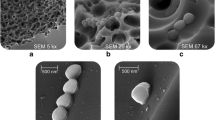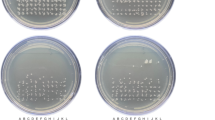Abstract
The isoelectric points of many microbial cells lie within the pH range spanning from 1.5 to 4.5. In this work, we suggest a CIEF method for the separation of cells according to their isoelectric points in the pH range of 2–5. It includes the segmental injection of the sample pulse composed of the segment of the selected simple ampholytes, the segment of the bioanalytes and the segment of carrier ampholytes into fused silica capillaries dynamically modified by poly(ethylene glycole). This polymer dissolved in the catholyte, in the anolyte and in the injected sample pulse was used for a prevention of the bioanalyte adsorption on the capillary surface and for the reduction of the electroosmotic flow. Between each focusing run, the capillaries were washed with the mixture of acetone/ethanol to achieve the reproducible and efficient CIEF. In order to trace of pH gradients, low-molecular-mass pI markers were used. The mixed cultures of microorganisms, Escherichia coli CCM 3954, Candida albicans CCM 8180, Candida parapsilosis, Candida krusei, Candida glabrata, Candida tropicalis, CCM 8223, Proteus vulgaris, Klebsiela pneumoniae, Staphylococcus aureus CCM 3953, Streptococcus agalactiae CCM 6187, Enterococcus faecalis CCM 4224 and Staphylococcus epidermidis CCM 4418, were focused and separated by the CIEF method suggested here. This CIEF method enables the separation and detection of the microbes from the mixed cultures within several minutes. The minimum detectable number of microbial cells was less than 103.







Similar content being viewed by others
Abbreviations
- AA:
-
L-aspartic acid
- c NaOH, Ca :
-
Concentration of NaOH in the catholyte solution (mM)
- c PEG, CaAn :
-
Concentration of PEG 4000 in the catholyte and in the anolyte solutions [% (wt/vol)]
- c PEG, inj :
-
Concentration of PEG 4000 in the spacer or sample segment [% (wt/vol)]
- DSS:
-
Dilution of the stock solution of the spacer
- Glu:
-
Glutamic acid
- Δh :
-
Height difference of the reservoirs at the siphoning injection
- MAA:
-
4-morpholinyl acetic acid
- Nic:
-
Nicotinic acid
- PSS:
-
Physiological saline solution
- t :
-
Migration time (min)
- t 4.9 :
-
Migration time of the pI marker zone 4.9 (min)
- Δt :
-
Difference between the migration time of the zones of p
- TAPSO:
-
N-[tris-(hydroxymethyl)-methyl]-3-amino-2-hydroxy-propanesulfonic acid
- t inj :
-
Injection time of the sample pulse components into the capillary (s)
References
Harden VP, Harris JO (1953) J Bacteriol 65:198–202
Jucker BA, Harms H, Zehnder AJB (1996) J Bacteriol 178:5472–5479
Rijnaarts HMH, Norde W, Lyklema J, Zehnder AJB (1995) J Colloids Surf BBiointerfaces 4:191–197
Van der Wal A, Norde W, Zehnder AJB, Lyklema (1997) J Colloids Surf B Biointerfaces 9:81–100
Ritvo G, Dassa O, Kochba MA (2003) Aquaculture 218:379–386
Horká M, Planeta J, Růžička F, Šlais K (2003) Electrophoresis 24:1383–1390
Horká M, Růžička F, Horký J, Holá V, Šlais K J (2006) Chromatogr. B (in press)
Armstrong DW, Schulte G, Schneiderheinze JM, Westenberg DJ (1999) Anal Chem 71:5465–5469
Jaspers E, Overmann J (1997) J Appl Environ Microbiol 63:3176–3181
Kenndler E, Blaas D (2001) TrAC 20:543–551
Desai MJ, Armstrong DW (2003) Microbiol Mol Biol Rew 67:38–51
Moses N, Rouxhet PG (1987) J Microbiol Methods 6:99–112
Righetti PG, Bossi A (1998) Anal Chim Acta 372:1–19
Conti M, Gelfi C, Righetti PG (1995) Electrophoresis 16:1485–1491
Conti M, Gelfi C, Bianchi-Bosisio A, Righetti PG (1996) Electrophoresis 17:1590–1596
Mohan D, Lee CS (2002) J Chromatogr A 979:271–276
Horká M, Willimann T, Blum M, Nording P, Friedl Z, Šlais K (2001) J Chromator A 916:65–71
Wehr T, Rodriguez-Diáz R, Zhu M (2001) Chromatographia 53:S45–S58
Righetti PG, Caravaggio T (1976) J Chromatogr 127:1–28
Lalljie SPD, Sandra P (1995) Chromatographia 40:519–526
Rodriguez-Diaz R, Wehr T, Zhu M (1997) Electrophoresis 18:2134–2144
Roosjen A, Kaper HJ, van der Mei HC, Norde W, Busscher J. (2003) Microbiology 149:3239–3246
Girod M, Armstrong DW (2002) Electrophoresis 23:2048–2056
Shimura K (2002) Electrophoresis 23:3847–3857
Righetti PG (2004) J Chromatogr A 1037:491–499
Kilár F (2003) Electrophoresis 24:3908–3916
Šlais K, Horká M, Nováčková J, Friedl Z (2002) Electrophoresis 23:1682–1688
Razatos A, Org YL, Boulay F, Elbert DL, Hubell JA, Sharma MM, Georgiou G (2000) Langmuir 16:9155–9158
Kaper HJ, Busscher HJ, Norde W (2003) J Biomater Sci Polymer Edn 14:313–324
Preisler J, Yeung ES (1996) Anal Chem 68:2885–2889
Kilár F, Végváry Á, Mód A (1998) J Chromatogr A 813:349–360
Zhang CX, Xiang F, Pasa-Tolic L, Anderson GA, Veenstra TD, Smith RD (2000) Anal Chem 72:1462–1468
Št’astná M, Trávníček M, Šlais K (2005) Electrophoresis 26:53–59
Hirokawa T, Nishino M, Aoki N, Sawamoto YKTY, Akiyama J-I (1983) J Chromatogr A 271:D1–D106
Acevedo F (1991) J Chromatogr A 545:391–396
Acknowledgement
This work was supported by the Grant Agency of the Academy of Sciences of the Czech republic No. A4031302.
Author information
Authors and Affiliations
Corresponding author
Rights and permissions
About this article
Cite this article
Horká, M., Růžička, F., Holá, V. et al. Capillary isoelectric focusing of microorganisms in the pH range 2–5 in a dynamically modified FS capillary with UV detection. Anal Bioanal Chem 385, 840–846 (2006). https://doi.org/10.1007/s00216-006-0508-0
Received:
Revised:
Accepted:
Published:
Issue Date:
DOI: https://doi.org/10.1007/s00216-006-0508-0




